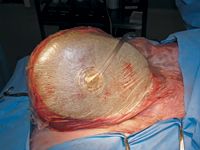CVC highlight: Wound therapy: The positives of negative pressure
Dr. Adin discusses a state-of-the-art wound treatment that helps trauma patients heal faster.
Skin defects in the early stages of healing, effusive wounds, or animals with septic peritonitis may benefit from the use of negative pressure wound therapy (NPWT).

Christopher Adin, DVM, DACVS
What is NPWT?
NPWT uses controlled suction to remove exudate, reduce tissue edema, and encourage granulation tissue formation in the early stages of wound healing (Figure 1). Suction is distributed over the entire surface of an open wound by the application of porous, open cell foam. An airtight seal is achieved by covering the foam with an adherent, occlusive bandage material. A portable therapy unit is connected to the foam with suction tubing, providing continuous negative pressure to the wound at a subatmospheric level (-125 mm Hg). While the machines can be set to create intermittent pressure, this setting is not commonly used in veterinary medicine as it can cause discomfort. Wound exudate is collected in a disposable, single-use reservoir.

1. An NPWT bandage being applied to an infected pelvic limb amputation site after surgical débridement of the wound. Application and maintenance of a wet-to-dry bandage in this location would be extremely challenging in this effusive wound, requiring general anesthesia for bandage changes twice daily. Use of an adherent NPWT bandage achieves fluid removal and allowed us to maintain the dressing for 48 hours before another bandage change was required.
NPWT applies two different kinds of strain to the wound that assist the formation of granulation tissue. First, it pulls the skin edges closer together, causing relaxation of the skin and easing closure of the wound. This is called macrostrain. Second, the microstrain created at a cellular level encourages wound fibroblasts to enlarge and divide more quickly than they would have without the pressure.
Advantages
This therapy takes the place of a wet-to-dry bandage and can yield observable results. The bandages need to be changed less often than wet-to-dry bandages, making them less time- and labor-intensive and, potentially, less expensive as hospitalization times can be decreased. One NPWT bandage can last two to three days; wet-to-dry bandages often need to be changed once, or even twice, daily.
One experimental study in dogs has shown that the time to establish a healthy granulation bed was reduced from six to seven days with wet-to-dry bandages to three to four days using NPWT.1
When to use it—and when not to
The indications for this type of wound management include:
- Clean, débrided, open wounds in early or granulation stages of healing
- Immediate postoperative incisions
- Immediate postoperative skin grafts
- "Open" peritoneal drainage
Contraindications include:
- Exposed blood vessels or intestine
- Patients with coagulopathies
- Wounds with malignant contamination
- Incompletely débrided wounds
- Patients with osteomyelitis
Key points
Keep the following in mind when using this form of wound closure:
- Patient hospitalization during treatment is usually required.
- It does not achieve débridement. You must surgically débride the wound before bandage application and when needed during treatment. This is essential to success when using this treatment.
- Do not use negative pressure any longer than seven days. This method can delay epithelialization after the granulation tissue bed is formed.
Christopher Adin, DVM, DACVS, Department of Veterinary Clinical Sciences, College of Veterinary Medicine, The Ohio State University, Columbus, Ohio.
REFERENCE
1. Demaria M, Stanley BJ, Hauptman JG, et al. Effects of negative pressure wound therapy on healing of open wounds in dogs. Vet Surg 2011;40(6):658-669.
Listen in
To hear Dr. Adin discuss the various parts of NPWT and how to use them together to produce the results you need, as well as NPWT's indications and contraindications, scan the QR code above, or go to dvm360.com/CVC13Adin.